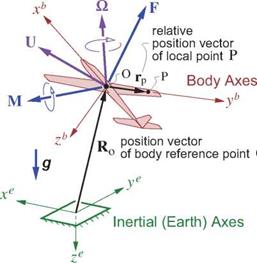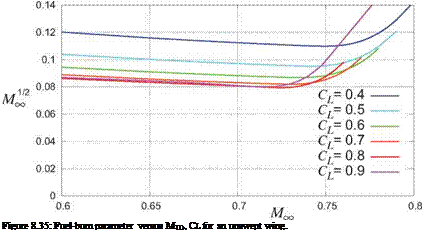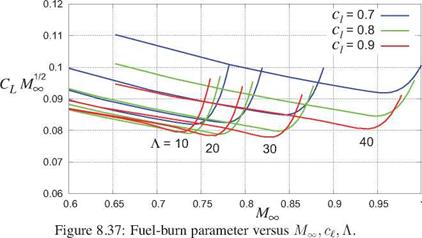Natural response
For the fixed-stick case of no control inputs, A 8 = 0, the general solution of the Linear Time Invariant (LTI) ODE system (9.35) is a superposition of eight flight-dynamics eigenmodes,
8
Ax(t) = ^2 Vk exp(Afct) , Afc = at + i Wfc (9.36)
k=l
where A1…8 are the nonzero eigenvalues and vl…8 are the corresponding eigenvectors of the Jacobian matrix A. Each of the remaining four zero eigenvalues corresponds to a shift in x, y, z, ф, which has no influence on the dynamics and hence is excluded from the mode summation.
The magnitude of each wt and the sign and magnitude of at indicate the nature of that mode. If wt = 0 then the motion is monotonic, and if wt = 0 then the motion is oscillatory. The latter actually consists of two complex-pair modes, A = a ± i w. If at > 0 then that mode is unstable, meaning that the aircraft will exhibit exponential divergence from the trimmed flight state.
9.8.3 Symmetry
In the completely general case, the A and B matrices of the linearized dynamics system (9.35) are nearly full. But if we have
• geometric symmetry (the airplane is left/right symmetric), and
• aerodynamic symmetry with v0 = p0 = r0 = ф0 = 0, and
• negligible onboard angular momentum, h ~ 0,
then A and 13 have the following form after the state vector and the equations are re-ordered as indicated. Zero or nearly zero matrix elements are shown blank.
![]()
![]() /
/
Au
AW A q aO
![]() AV A p
AV A p
}
Ar
А ф Axe A Vе A ze A^
T J
The first four rows constitute the Longitudinal Dynamics subset, the middle four rows are the Lateral Dynamics subset, and the last four rows are the Navigation subset.
The last four navigation variables Axe, Aye, Aze, Aф generally have zero matrix columns, even for asymmetric aircraft. This implies that the matrix will have at least four zero eigenvalues, Аддо,11,12 = 0, whose corresponding eigenmodes contain only the steady displacements of the four navigation variables.
 Vg exp(0t) = { V10 exp(0t) = { V11 exp(0t) = {
Vg exp(0t) = { V10 exp(0t) = { V11 exp(0t) = {
V12 exp(0t) = {
This is expected from coordinate invariance – the dynamics cannot be affected if the airplane position is displaced, or if it is pointed in another direction in the plane parallel to the Earth surface. This justifies excluding these four trivial steady displacement modes from the dynamical mode summation (9.36).
One notable exception occurs if atmospheric property variation is significant over the vertical extent of the motion. In this case there will be some dependence on the Aze variable, and there will be only three trivial modes present in the system.
[1] If only one type of singularity is present (e. g. only vorticity but no source density), and if in addition the overall lumped vortex strength Г is nonzero, then the far-field doublets can be made to vanish by a suitable choice of the vortex location, which is then defined as the vorticity centroid. In the case of the thin airfoil, this location is also the center of lift, defined as the point about which the pitching moment is zero.
[2] For favorable pressure gradients a> 0, the velocity profile is “full” near the wall, with a monotonic curvature, relatively large skin friction coefficient Cf values, and small shape parameter H values.
• For adverse pressure gradients a< 0, the velocity profile is inflected, with a smaller skin friction and large shape parameters H.
• There is a minimum value a ~ -0.0904, which is the incipient-separation case, with Cf =0 and H ~ 4.029 . For a less than this minimum, no physical self-similar solution of the boundary layer equations (4.21) exists.
• Separated-flow solutions with Cf < 0 and H > 4.029 do exist, but their a parameter is less negative than the minimum value. They also exhibit reversed flow U < 0 near the wall.
[3] Forced transition.
This is caused by a geometric feature on the surface, such as a panel edge, rivet line, or an intentionally – placed “trip strip.” If the feature’s size is comparable to the height of the local boundary layer, as measured by the displacement thickness for example, then it is a strong receptivity site where the external disturbances can enter the boundary layer. These are usually sufficiently strong to trigger transition to turbulence a short distance downstream.
[4] Natural transition.
This occurs on relatively smooth surfaces in quiet flow, when the external disturbances are extremely weak and the resulting initial disturbances or oscillations in the boundary layer are very weak as well. Examples are external flows in flight or in a quiet wind tunnel. The initial disturbances are amplified by natural flow instabilities and increase exponentially in amplitude downstream, and eventually become strongly chaotic. The changeover to chaotic turbulent flow defines the transition location. Transition of this type can be predicted by the so-called eN methods [37], [38]. One example of such a method is summarized in the next section.
[5] Bypass transition.
This occurs only in very noisy environments, where the disturbances in the outer inviscid flow are
[6] Relative to the streamtubes of the incompressible case where a = 0, the compressible case shows a divergence of the streamtubes in the front where a > 0, and a convergence of the streamtubes in the rear where a < 0. This results in a thickening of the streamtubes over most of the airfoil, which is quantitatively shown in Figure 8.4.
[7] For a sufficiently fat body, at some point depending on MTO, it is necessary to switch to the PP2 or FP
[8] Far downstream in the Trefftz plane, fairly close to the x axis so that x2 ^ y2 + z2, we have the incompressible flow about two 2D vortices of strength ±Г, located at (y, z) = (±b/2, 0).











 actual state later perturbation
actual state later perturbation









